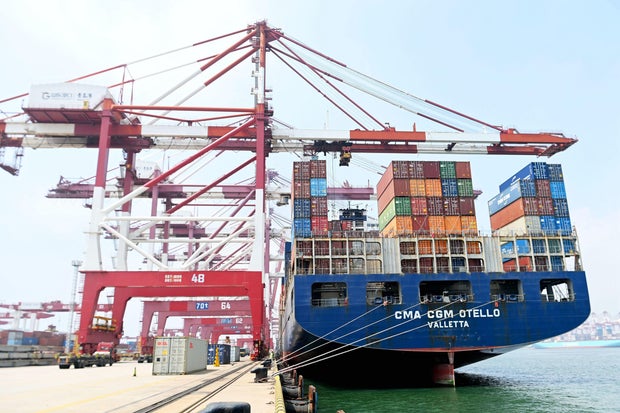What do dockworkers do, and which parts of the job are automated?
The three-day dockworker strike that crippled East and Gulf Coast ports put a spotlight on one of America’s most important jobs: loading and unloading the billions of products — from food to cars — that keep the U.S. economy humming.
Although the work stoppage has ended for now, the labor dispute reflects how robots, artificial intelligence and other potent technologies are changing the nature of operations in the nation’s supply chains and in other industries.
“We’re really at a moment here where we’re taking about the future of work and what that looks like in America and around the world,” John Samuel, managing director with consulting firm AlixPartners, told CBS News. “And so, how do we combine the natural evolutions of technology with the right to human decency and human work?”
The tentative agreement announced on Friday between the International Longshoremen’s Association — which led last week’s strike — and the United States Maritime Alliance, bridges the divide on wages, giving dockworkers an immediate $4 per hour raise and a $24 per hour pay hike over a six-year labor contract.
Yet the pact doesn’t resolve worker concerns over automation. Read on to learn about what dockworkers do and how new technologies are changing the job.
From boxes, bails and bundles to containers
In recent decades, longshore work has been transformed by technology, a key sticking point in the labor dispute that pitted unionized workers against shipping companies and port operators.
Dockworkers handle freight by loading and unloading cargo ships that come to port. Up until the late 1950s, that meant carrying boxes, bails and bundles of goods by hand from incoming ships into storage, before loading them onto trains for transport to their final destination.
Today, cargo is stored in large, standardized containers — designed to be transported by ship, rail or truck — that dockworkers handle with cranes and other equipment.
“It’s all about operating the lifting equipment that’s required to move the containers around. A lot of it is transferring containers from ship to shore, and vice versa,” Kent Gourdin, professor and director of the global logistics and transportation program at College of Charleston, told CBS MoneyWatch. “They handle containers on the terminals where ships dock, and keep track of what container needs to go where.”
These days, the job largely involves operating machinery, as well as tracking cargo and keeping records. For example, dockworkers coordinate with trucking companies that come to port to retrieve containers and transport them to their next stop. Dockworkers are also responsible for securing cargo on ships. Containers are stacked on top of one another, and it’s dockworkers’ job to make sure the containers are latched together.
Although operating heavy machinery is less physically arduous than toting boxes, nearly all dockworkers “are out in the weather to some degree and working in an environment where they are surrounded by heavy equipment,” Gourdin said.
“Whereas back in the day it was labor-intensive, today it’s mainly about operating machinery,” Henry Sims Jr., a fourth-generation longshoreman and president of the ILA local 3,000 in New Orleans, told CBS MoneyWatch. “Now, you have to be skilled. You can’t hire someone off the street, because they wouldn’t be able to do it without killing somebody, or themselves.”
U.S. behind in automation
The 10 largest U.S. ports all use some kind of automation technology to move cargo, according to a March GAO report. These include automated gates, which let trucks and containers move through cargo terminals with limited worker interaction; so-called port community systems, which are digital platforms that automatically streamline logistics and supply-chain data; and technologies used in “internet-of-things” systems, such as RFID, GPS and cameras, to operate equipment and track containers.
Semi-automated terminals employ people to operate machinery that moves containers from the cargo berth — the area where a ship is moored — to the yard. Equipment used to stack containers on top of one another is fully automated.
But only three domestic ports, Long Beach Container Terminal in Long Beach, California; and TraPac and APM Terminal Pier 400 in Los Angeles are fully automated.
At fully automated ports, both horizontal and vertical container movement is handled by machines. Other technologies put to use at automated ports include AI-powered sensors, digital twins — or identical, digital replicas of ports — and blockchain to automate recording transactions and track container locations.
Automated cargo-handling equipment eliminates the need for humans on site to operate a crane, for example, according to a U.S. Government Accountability Office report on port automation.
“Ports in other parts of the world are much more advanced than in the U.S., partly because the unions have been blocking the adoption of technology and automation,” global supply chain management expert Chris Tang told CBS MoneyWatch.
“If you go to modern ports in China, you hardly see any humans,” he said. “They use automated cranes, and when a ship comes in a crane picks up the containers to stack them.”
Costfoto/NurPhoto via Getty Images
Despite the shift toward automation, Sims Jr. said human workers remain essential to the industry.
“We move things more efficiently and productively than automation does. The machines are slower, and when they break down, they can’t go back to work until we get someone out there to look at it and fix it.”
Gourdin, the professor, backed up that claim.
“Machines, I think, can do the job as well, but people are faster. I’ve been to automated terminals and it’s just slower,” he said, while acknowledging that more fully automated ports in the U.S. may be inevitable.
“An extremely difficult problem”
Given the close coordination that is required between ships, trucking companies and their customers, artificial intelligence and data analytics can play a big role in getting a container from point A to point B, logistics experts say.
“Dockworkers communicate with trucking companies to find cranes to use to retrieve their containers when they’re arriving,” Tang explained. “But sometimes a trucker will show up and they’ll need a container that’s at the bottom of the pile. This is a problem.”
That’s where artificial intelligence and data analytics come in. These technologies help dockworkers track when a given container will arrive and coordinate with trucking companies for pick-up, affecting how containers are stacked.
“It’s an extremely difficult problem to solve — to synchronize when the container and truck are coming in. This is where automation comes into play,” Tang said.
Robert Atkinson, president of the Information Technology and Innovation Foundation, said automation is well suited to the port system given how routine the nature of the work is.
“Ship comes in, they have all these containers loaded up, you take off the container and move it somewhere. Then you put it on an intermodal train or truck,” he said. “It’s the same thing over and over again. That’s something that technology can do really well because there is little variation.”
Atkinson favors cutting the amount of human labor in U.S. ports by 50% over the next 10 years, while he notes that remaining workers who survive would see their wages rise and consumers would save on shipping costs. Of course, that’s just the kind of major workforce reduction the dockworkers’ union is intent on preventing.
“If you automate a port, that means you buy something form a furniture store online and it costs less,” he said. That leads to savings for middle-class Americans.”





